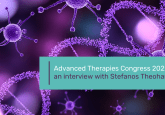Connecting, conferencing and collaborating: an interview with Jessica Robinson

In the interview, we spoke to Jessica Robinson, project director of the Advanced Therapies Congress (24-25 May, London, UK). Here, she discusses the challenges she sees the cell and gene therapy industry facing, and how networking and connecting at conferences can help address knowledge and skills gaps.
What do you think sets this meeting apart from the rest?
We are the largest commercially focused advanced therapy medicinal product (ATMP) event in Europe. Our mission is to address and tackle the challenges in commercializing these therapies and get them into patients. However, we capture a cross section of the development pipeline; we bring together the key players, from industry, academia, the clinic, start-ups and investors, all under one roof. The agenda covers very early-stage research and development, clinical development and manufacturing and finally, evidence, pricing and access and delivery to patients.
What are the greatest challenges faced by the industry?
I think are three main challenges in the industry. The first is the cost of manufacturing is incredibly high, which is very obstructive and technically difficult. The second is pricing and market access; the cost of manufacturing contributes to this, as does the cost of clinical trials. Although patient access is key, currently these treatments are not very affordable for most patients. Therefore, we need to address how health technology assessors, healthcare authorities and governments are going to get these therapies into patients in hospitals. The third is the supply chain that delivers these delicate cell and gene therapies that need cryopreservation and special handling to patients into clinical settings. It’s technically very difficult to process these therapies, deliver them safely and ensure they remain healthy when they reach patients.
However, there are other challenges too; addressing the skill shortage by ensuring the right people are training to the required technical level will be important. There is a huge bottleneck here, which has been made worse by the COVID-19 pandemic.
How can start-ups benefit from attending?
For the first time, in 2022 we brought together 100 start-ups to showcase their work; all were less than 4 years old and have fewer than 20 employees, so it was great to see companies new in the space demonstrating the next technologies and therapeutic offerings. We were really proud of this – next year we’re aiming to showcase 200 companies. I hope this can help with networking as well; the start-ups are looking to meet potential partners and investors, but our audience, who are from industry, investors and also solution providers, want to meet with new potential clients and partners as well. Overall, I think it’s a great asset and a great feature of our show.
How has the industry dealt with COVID; have they gained or lost anything?
We carried out two major virtual events during the pandemic. Our virtual event in 2020 was very reactive, but in 2021 we worked very hard to run some great virtual classes. Throughout this, we’ve managed to continue growing our audience, with 2000 people registering for the 2021 event and 1600 people attending. In 2022, at our first in-person event post-COVID, we have 1200 people attending; I think this shows there is a great appetite in the industry to meet face-to-face again.
How are you able to collaborate and coordinate with other conferences and organizations worldwide?
Since the pandemic, we’ve realized that although some competition is healthy, to push the industry forward and bring the benefits to patients, we really need to work together. This year, we’ve partnered with the International Society for Cell and Gene Therapy (ISCT) and the Alliance for Regenerative Medicine (ARM) to promote each of our conferences and make sure we are getting the right people on our agendas, enabling cross-pollination of ideas to keep our events successful.
What do you want to see for the future of the cell and gene space?
More diversity in terms of offerings would be good; what we’re seeing from some of our start-ups is that they are using some interesting and very new technologies, such as AI, lipid vesicles and innovative gene delivery systems. We’re reaching the next stage in terms of next generation therapeutics, where different technologies are interlinking and working together. I also see people working together more, rather than companies keeping their technologies and knowledge to themselves. There will always been supermassive companies which buy or invest in small communities, but it’s great to see variety and collaboration.
Disclaimer
The opinions expressed in this interview are those of the interviewees and do not necessarily reflect the views of RegMedNet or Future Science Group.


